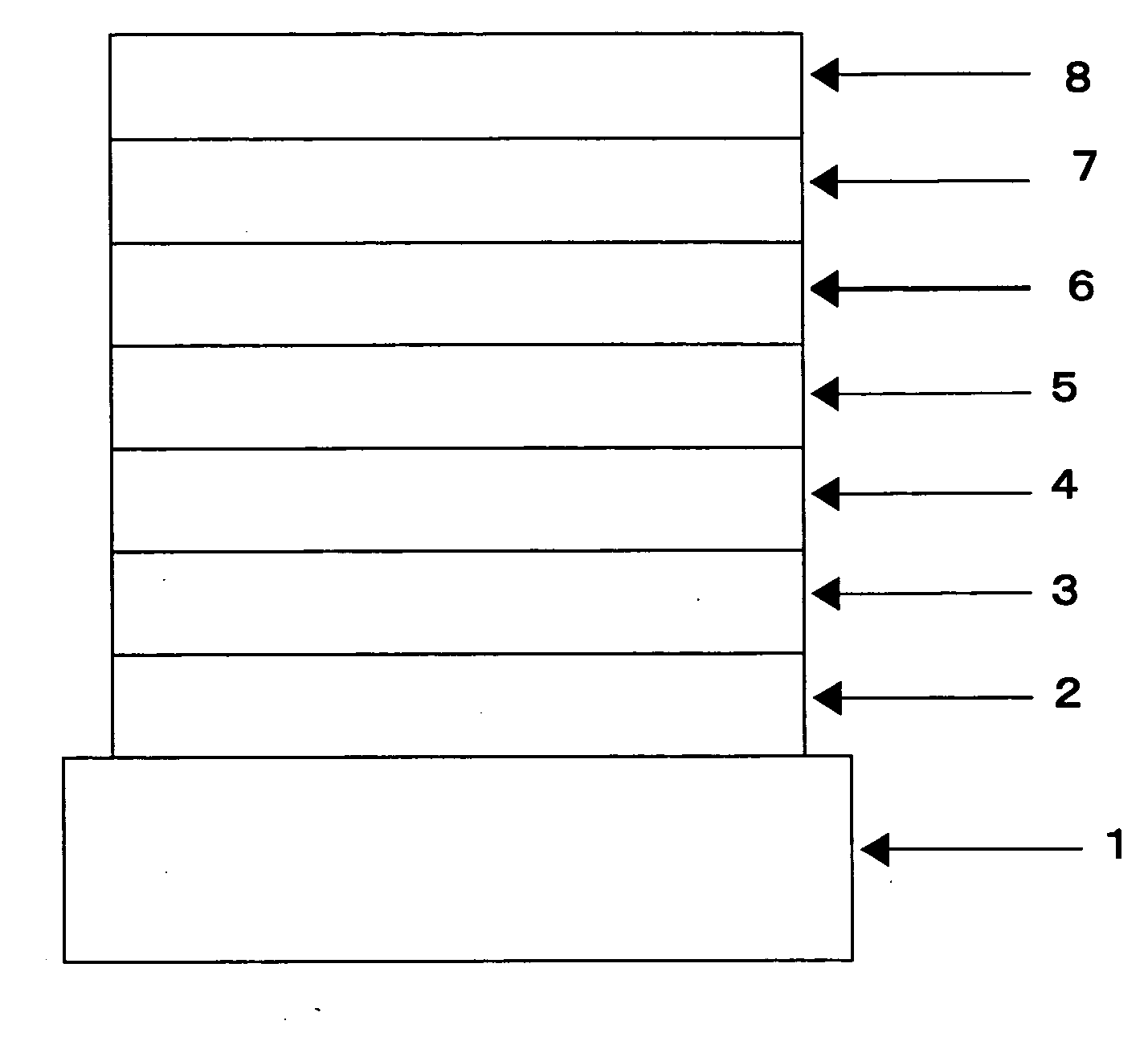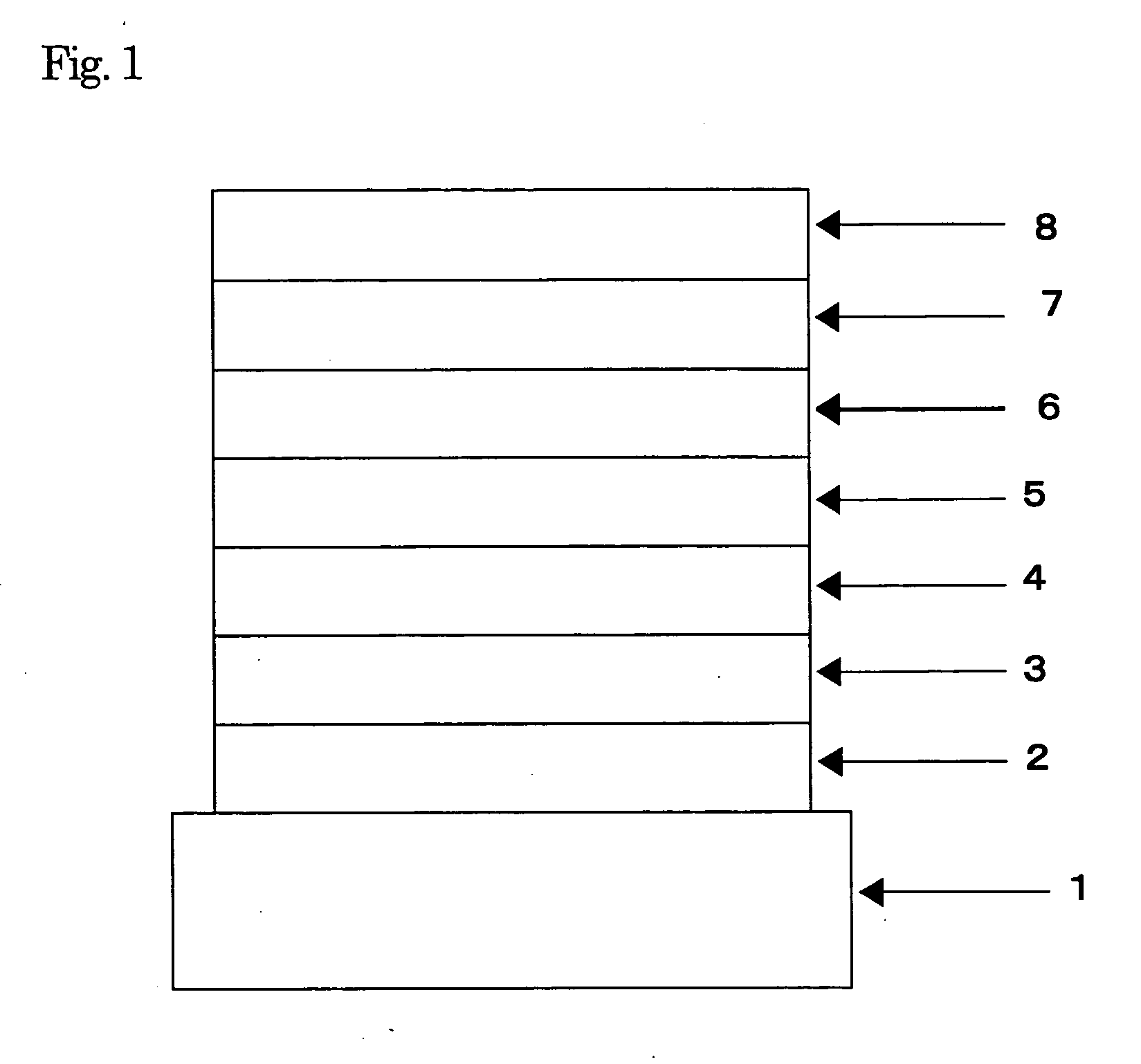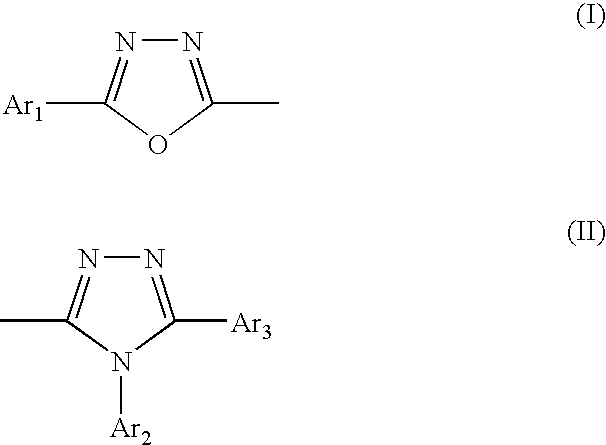Organic electroluminescent element
a technology of electroluminescent elements and organic materials, applied in the direction of discharge tube/lamp details, discharge tube luminescent screens, discharge tubes/lamp details, etc., can solve the problems of difficult observation of tg, deterioration of thin film shape, and inability to achieve high efficiency, etc., to achieve good driving stability, improve driving stability and heat resistance, and improve the effect of stability
- Summary
- Abstract
- Description
- Claims
- Application Information
AI Technical Summary
Benefits of technology
Problems solved by technology
Method used
Image
Examples
synthetic example 1
Synthesis of 3-[4-(phenyl-1,3,4-oxadiazolyl-(5))-phenyl]-4,5-diphenyl-1,2,4-triazole (Hereinafter Referred to as POT)
[0069] The reactions involved in the synthesis are shown below.
[0070] The reaction of compound (6) with compound (8) to give POT is described below.
[0071] In a 1000-ml four-necked flask were placed 43.6 g (0.150 mole) of compound (6), 64.8 g (0.300 mole) of compound (8) and 493.1 g of pyridine and the mixture was heated to 114° C. and heated there under reflux for 2 hours. After the reaction, the reaction mixture was thrown into 3000 ml of methanol and the precipitated crystals were collected by filtration, washed with 1500 ml of methanol and dried at 100° C. under reduced pressure to give 1.3 g of dried crystals. The crystals were recrystallizerd three times from dimethylformamide to give 31.0 g of purified crystals of POT; purity 99.97% (HPLC area ratio), mass analysis value 441, melting point 273.0° C., yield 46.8%. POT is compound No.1 in Table 1.
[0072] The r...
synthetic example 2
Synthesis of 3,4-bis[4-(2-phenyl-1,3,4-oxadiazolyl-(5))-phenyl]-5-phenyl-1,2,4-triazole (Hereinafter Referred to as 3,4-BPOT)
[0074] The reactions involved in the synthesis are shown below.
[0075] The reaction of compound (14) with compound (10) to give 3,4-BPOT is described below.
[0076] In a 200-ml four-necked flask were placed 6.1 g (0.011 mole) of compound (14), 4.9 g (0.034 mole) of compound (10) and 73.3 g of pyridine and the mixture was heated to 117° C. and heated there under reflux for 2 hours. After the reaction, 100.9 g of methanol was added to the mixture and the precipitated crystals were collected by filtration and recrystallized from methylene chloride to give 3.6 g of purified crystals of 3,4-BPOT: purity 99.16% (HPLC area ratio), mass analysis value 585, melting point 324.0° C., yield 55.9%. 3,4-BPOT is compound No. 55 in Table 8.
[0077] The result of the IR analysis of 3,4-BPOT is shown below.
[0078] IR (KBr) 3448, 3060, 2920, 2856, 1932, 1612, 1582, 1550, 1502, 1...
synthetic example 3
Synthesis of 3,5-bis[4-(2-phenyl-1,3,4-oxadiazolyl-(5))-phenyl]-5-phenyl-1,2,4-triazole (Hereinafter Referred to as 3,5-BPOT)
[0079] The reactions involved in the synthesis are shown below.
[0080] The reaction of compound (19) with compound (10) to give 3,5-BPOT is described below. In a 300-ml four-necked flask were placed 5.6 g (0.011 mole) of compound (19), 4.2 g (0.030 mole) of compound (10) and 87.9 g of pyridine and the mixture was heated to 117° C. and heated there under reflux for 2 hours. After the reaction, 136.5 g of methanol was added to the mixture and the precipitated crystals were collected by filtration and recrystallized from methylene chloride to give 3.3 g of purified crystals of 3,5-BPOT: purity 99.31% (HPLC area ratio), mass analysis value 585, melting point 344.1° C., yield 51.3%. 3,5-BPOT is compound No. 37 in Table 5.
[0081] The result of the IR analysis of 3,5-BPOT is shown below.
[0082] IR (KBr) 3452, 3060, 2924, 1612, 1548, 1472, 1450, 1412, 1314, 1270, 11...
PUM
 Login to View More
Login to View More Abstract
Description
Claims
Application Information
 Login to View More
Login to View More - R&D
- Intellectual Property
- Life Sciences
- Materials
- Tech Scout
- Unparalleled Data Quality
- Higher Quality Content
- 60% Fewer Hallucinations
Browse by: Latest US Patents, China's latest patents, Technical Efficacy Thesaurus, Application Domain, Technology Topic, Popular Technical Reports.
© 2025 PatSnap. All rights reserved.Legal|Privacy policy|Modern Slavery Act Transparency Statement|Sitemap|About US| Contact US: help@patsnap.com



